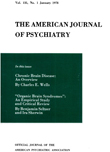Changing epidemiology of tardive dyskinesia: an overview
Abstract
Dyskinesia is found significantly more often among neuroleptic-treated psychiatric patients than among non-neuroleptic-treated patients. The epidemiology of tardive dyskinesia is changing; its reported prevalence among neuroleptic-treated psychiatric inpatients has been progressively rising and has reached 25% during the past five years. The prevalence of persistent tardive dyskinesia that may be attributable to neuroleptics is about 13%. Tardive dyskinesia is not restricted to old, brain-damaged inpatients but also occurs with a noticeable frequency among younger patients, including outpatients, treated neuroleptics. Yet neuroleptics are the most effective available treatment for schizophrenia; hence, any drastic curtailment of their use in the treatment of chronic schizophrenic patients may not be justified. Cautious use of these drugs, along with intensified research on tardive dyskinesia is warranted.
Access content
To read the fulltext, please use one of the options below to sign in or purchase access.- Personal login
- Institutional Login
- Sign in via OpenAthens
- Register for access
-
Please login/register if you wish to pair your device and check access availability.
Not a subscriber?
PsychiatryOnline subscription options offer access to the DSM-5 library, books, journals, CME, and patient resources. This all-in-one virtual library provides psychiatrists and mental health professionals with key resources for diagnosis, treatment, research, and professional development.
Need more help? PsychiatryOnline Customer Service may be reached by emailing [email protected] or by calling 800-368-5777 (in the U.S.) or 703-907-7322 (outside the U.S.).



